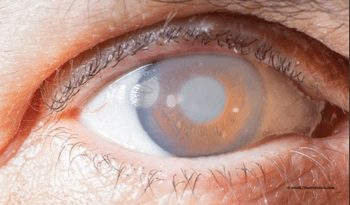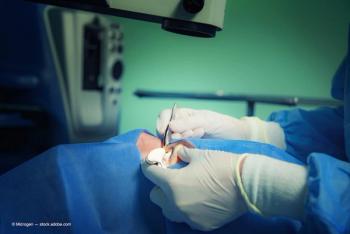
Allie Holmes, head of US marketing for Johnson & Johnson Surgical Vision, shares an update on what visioning the company is doing with their new and elevated technologies.

Allie Holmes, head of US marketing for Johnson & Johnson Surgical Vision, shares an update on what visioning the company is doing with their new and elevated technologies.

TP-03 met the primary and all secondary endpoints, effectively resolved Demodex blepharitis and was well-tolerated with no serious treatment-related adverse events. 56% of patients on TP-03 achieved the primary endpoint of complete collarette cure.

Riad Sherif, MD, CEO of Oculis, gives a company update on clinical trials for products in DME, ocular surgery, and more; plus, growing products in glaucoma treatments, team and financing updates.

Kevin Waltz, a consultant for ViaLase, discusses the company's technology: an image-guided femtosecond laser surgical system for the treatment of glaucoma.

George Waring, MD, discusses the findings of a retrospective study on Allergan’s AGN-190584 for the treatment of presbyopia.

Mark Packer, MD, discusses the causes, factors, and treatments of negative dysphotopsia.

Last year, the company announced the data from the Saturn-1 study for TP-03, the first potential product to treat Demodex blepharitis, and the product is now in the phase 3 trial (Saturn-2). Aziz Mottiwala, chief commercial officer for Tarsus, gives a company update on the pipeline for their program for Demodex blepharitis.

Earlier this year, BioTissue announced the corporate rebrand of its new customer facing entity, including carrying the name over to its surgical business formally known as Amniox Medical. Randy Mansfield, VP of marketing for BioTissue, shares an update at ASCRS 2022.

Greg Kunst, president and CEO of Aurion BioTech, shares a company update on endothelial cell therapy trials, clinical plans and upcoming data.

Dr. Sri Ganesh, MBBS, MS, DNB, chairman and managing director of Nethradhama Hospital Pvt. Ltd, discusses his studies on LENSAR and shares his findings.

Ben Bergo, CEO of Visus Therapeutics, gives a company update on the company's presented phase 2 data, and what's next in the pipeline.

John Berdahl, MD, discusses the technique and benefit of endothelial cell therapy. An early technology, this therapy method allows for up to 100 treatments out of a single human cornea.

Chuck Hess, vice president and general manager, Bausch and Lomb, discusses XIPERE™, the first and only therapy available in the United States that utilizes the suprachoroidal space to treat patients suffering from macular edema associated with uveitis, and other new things rolled out recently from the company.

Tom Frinzi, executive chairman of ViaLase, a new company based in Orange County, gives an update on the company, sharing some exciting new things happening.

This advancement reinforces Alcon’s commitment to surgeon training and education, as part of the Alcon Experience Academy. The new device will be introduced at the upcoming ASCRS meeting and surgeons will be able to experience the new technology firsthand.

The challenge has been in early detection of inflammation. Matrix metalloproteinase-9 (MMP-9), an inflammatory biomarker consistently elevated in the tears of dry eye patients, may accelerate early diagnosis when detected.

NCX 470 is currently enrolling patients in two multi-regional Phase 3 glaucoma clinical trials, Mont Blanc and Denali. The objective of these two trials is to demonstrate statistically superior IOP lowering of once daily dosed NCX 470

The data support the ongoing development of KPI-012, a novel investigational secretome therapy, to address the complex wound healing process in persistent corneal epithelial defect (PCED).

Orbis International celebrates 40 years of innovation this year, beginning in 1982 with their iconic flying eye hospital. Since their start, Orbis has continued their innovation, working to achieve sustainable and scalable impact in the countries where they work. Doris Macharia, MD, senior vice president of global programs with Orbis, talks with Ophthalmology Times' Sheryl Stevenson, reflecting on the last 40 years and what's to come.

The International Agency for the Prevention of Blindness (IAPB) recently announced an expansion of their ‘Focus on Glaucoma’ and ‘Focus on Diabetes’ series with their new ‘Focus on Child Eye Health’ series in partnership with CooperVision.

The company announced the expansion of its commercial rollout of its MIGS implant to the UK

Vanderbilt’s David Calkins, PhD, was honored with the 2022 President’s Award, presented by the Glaucoma Research Foundation, at the Glaucoma 360 Annual Gala last month.

A team of investigators has found that nomacopan, a recombinant biologic derived from blood-feeding ticks, may be an option for the treatment of allergic eye disease due to its ability to down-regulate the LTB4/C5 pathways in experimental allergy conjunctivitis.